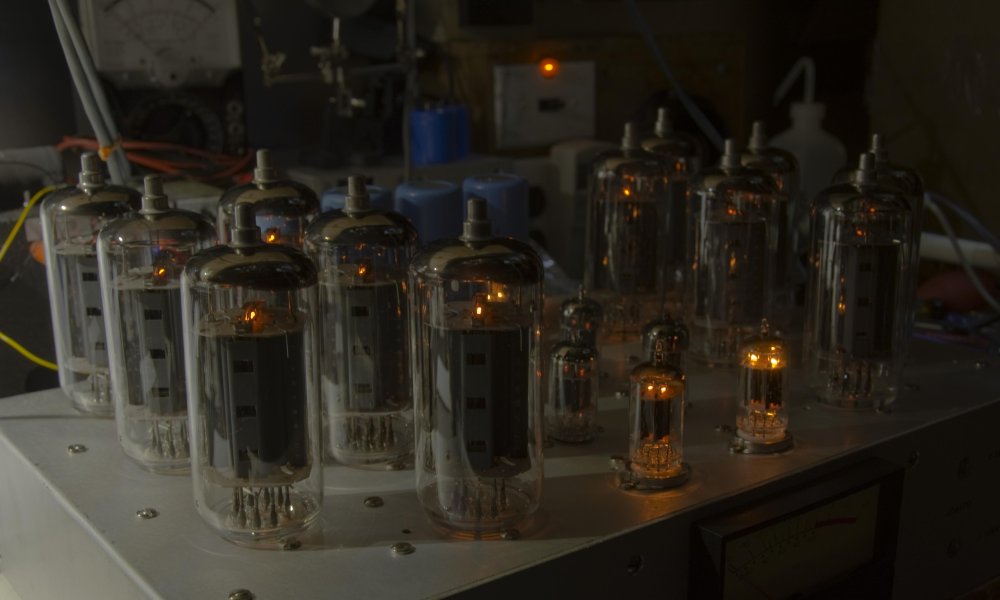Way back in the '60's I wanted to build a hi fidelity amplifier, but could not afford the output transformer of that quality. So I looked over several tubes that had low plate resistance and settled on the 8020/6AS7 back then and built an amp with 3 6AS7's. It put out 25W into 16? loads and was flat from 10-100,000cps, at least as best I could tell on my Heathkit oscilloscope of that era.
Well after repairing and upgrading a few Phase-Linear amplifiers for fellow audiophile clients, which pays well, I decided I still enjoy this hobby. I updated some of my test gear and have spectrum analyzers, distortion analyzers, all sorts of signal generators, meters, power supplies, frequency counters, oscilloscopes, etc.
So at this point, I have a strong desire to revisit my OTL vacuum tube amp design, update it a bit, increase the power.
So here's my thought. Using Circlotron topology (really just a fancy name for a push pull cathode follower output) and some ultra low plate resistance sweep tubes, a solid state power rectifier (power supply will be transformerless too, making this amp as dangerous as the 5 tube AC/DC radios of the 1950s) maybe opto-coupled input stage to isolate source components and a couple 12AT7s in the gain preamp stages. Similar to Futterman's designs. I'm looking at 6C33 tubes, but also find the 6P45 a very attractive alternative. Allen Kimmel claims he achieved 125W RMS into 8? with just four EL509 (6P45) beam tetrodes in the output stage. 200W peak (and then his power supply sagged). So four tubes per channel would give me a nice 125wpc with headroom to 200wpc.
EL509/6P45 can do 1400mA plate current at 140V plate potential, per tube. Plate resistance is 80? and can be forward biased to reduce that figure substantially. Kimmel's amp claims to have a .8? output impedance, for a damping factor of 10 into 8? speakers.
This will be the lightest tube amp of substance ever built, being not one piece of iron on the chassis. I even have ideas for powering the filaments (2 amperes a piece for the 6P45) without a transformer, if possible.
Another goal for this amp is to have all stages DC coupled. A lot of cathodyne drive circuits, cathodes directly feeding control grids of the next stage, etc. Only one cap at the input. The rest servo feedback balanced to keep the DC balance across the load.
It should be a fun project. Have to wait for some of my stuff to sell on ebay, then buy chassis, Magnovel tube sockets, 6P45 tubes (from Russia), some electrolytic caps for the power supply, etc. I have most of the rest of the tubes, resistors and other parts. Planning to run strips of 2oz copper PCB as ground bus all around the inside of the chassis for ground ties, terminated at the input jack.
This project is about having fun and meeting the 'no transformers' challenge I've set for myself, while producing a useable amplifier with decent power output.
Well after repairing and upgrading a few Phase-Linear amplifiers for fellow audiophile clients, which pays well, I decided I still enjoy this hobby. I updated some of my test gear and have spectrum analyzers, distortion analyzers, all sorts of signal generators, meters, power supplies, frequency counters, oscilloscopes, etc.
So at this point, I have a strong desire to revisit my OTL vacuum tube amp design, update it a bit, increase the power.
So here's my thought. Using Circlotron topology (really just a fancy name for a push pull cathode follower output) and some ultra low plate resistance sweep tubes, a solid state power rectifier (power supply will be transformerless too, making this amp as dangerous as the 5 tube AC/DC radios of the 1950s) maybe opto-coupled input stage to isolate source components and a couple 12AT7s in the gain preamp stages. Similar to Futterman's designs. I'm looking at 6C33 tubes, but also find the 6P45 a very attractive alternative. Allen Kimmel claims he achieved 125W RMS into 8? with just four EL509 (6P45) beam tetrodes in the output stage. 200W peak (and then his power supply sagged). So four tubes per channel would give me a nice 125wpc with headroom to 200wpc.
EL509/6P45 can do 1400mA plate current at 140V plate potential, per tube. Plate resistance is 80? and can be forward biased to reduce that figure substantially. Kimmel's amp claims to have a .8? output impedance, for a damping factor of 10 into 8? speakers.
This will be the lightest tube amp of substance ever built, being not one piece of iron on the chassis. I even have ideas for powering the filaments (2 amperes a piece for the 6P45) without a transformer, if possible.
Another goal for this amp is to have all stages DC coupled. A lot of cathodyne drive circuits, cathodes directly feeding control grids of the next stage, etc. Only one cap at the input. The rest servo feedback balanced to keep the DC balance across the load.
It should be a fun project. Have to wait for some of my stuff to sell on ebay, then buy chassis, Magnovel tube sockets, 6P45 tubes (from Russia), some electrolytic caps for the power supply, etc. I have most of the rest of the tubes, resistors and other parts. Planning to run strips of 2oz copper PCB as ground bus all around the inside of the chassis for ground ties, terminated at the input jack.
This project is about having fun and meeting the 'no transformers' challenge I've set for myself, while producing a useable amplifier with decent power output.


